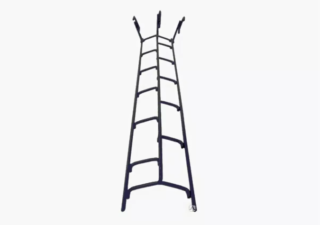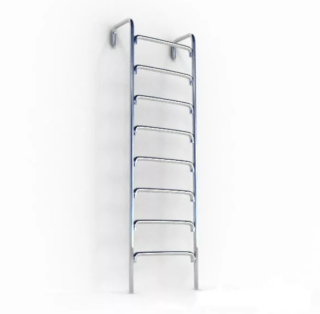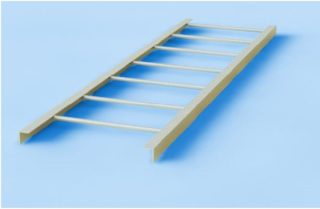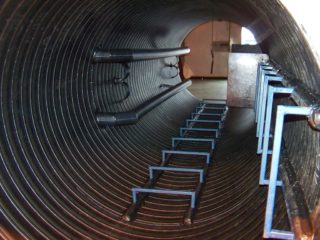The scope of use of drain ladders is clearly defined: they must provide access to communications laid in wells, in basements, in concrete collectors. They are used by services specializing in the repair and maintenance of engineering systems.
Definition and purpose of downspouts

Sewerage and water supply systems in large cities are a complex and extended facility that requires periodic preventive maintenance and constant repairs. Accidents often occur, which can be eliminated if there is access to underground utilities. It is provided by inspection wells formed from reinforced concrete rings. They are equipped with hatches and special "transport" systems - water ladders.
These are reliable structures designed for lowering and lifting people who are in the service of public utilities. The ladder must be able to support the weight of a large person holding a repair tool. On such devices, heavy equipment often descends into the collectors: cables, diagnostic systems, welding machines. There are three different types of described structures:
- drainage;
- sewer;
- heating network.
All three varieties have the same details: two parallel rungs that are secured with transverse rungs. But each model also has its own technical features.
Gutter ladders

They are made from a metal rod. The upper part of the two rails is bent in a hook shape. They provide attachment to the well ring. Such products are marked with the letters "VL" or "L" and are intended for installation in drainage, drainage or water supply wells.
To ensure safe descent, the described systems must be installed to the wall of the well and have the required length. The possibility of extension is allowed, but in the regulatory documents it is allowed to increase the length by no more than 50% of the original size. Each span of increased length must be attached to the wall of the well.
Sewer ladders
Instead of two, they have three guides. This design feature allows the equipment to be strengthened as close as possible to the walls of the launching well and to ensure maximum safety for the descending person, on whose shoulders there is heavy repair equipment. The risk of falling is minimal. This is also achieved through the special arrangement of the crossbars. The designation "КЛ" is used for marking. The product must be attached not only to the wall, but also to the neck of the hatch.
Heating network stairs

The simple design does not provide for the presence of fasteners, therefore, such products are simply installed in the wells before lowering, and then removed after lifting. They belong to the class of portable equipment that is part of the repair equipment. Heating ladders are not designed for lifting and lowering heavy equipment. Products are marked with letters "LTS-1" or "L-16".
It is allowed to use stationary installations ("L-15"), which are additionally equipped with handrails. The permissible height of such a structure is four meters.At the ladder for the inspection well, the guides are made of a metal corner, and the steps are made of smooth reinforcement.
Each product is usually accompanied by a drawing, as well as a technical data sheet. It indicates the length of the object, as well as the diameter of the reinforcement used, weight in kilograms, step height.
Main parameters and technical characteristics
The design and equipment of elements that provide the ability to descend into engineering wells must comply with the requirements of SNiP and GOST. They determine the technical characteristics of products: weight, length, height, choice of material and methods of processing. The main parameters are displayed in the documents attached to the product, they help to choose and purchase the described equipment correctly.
- The mass of the ladder is not constant. But there are maximum and minimum values for each type of product. For example, a meter of stairs to a sewer well should not weigh more than 25 kg. A step-ladder of a stationary class VL-2 has a maximum mass of one meter up to 45 kg.
- The length of the product according to GOST must correspond to the height of the well, but it must not be less than 11 m.
- The reliability of the structure is determined by the weight that the stairs of the launching equipment can withstand. According to the standards, it is assumed that each can withstand a weight of up to 120 kg (the mass of a person with repair equipment).
- The current rules determine the choice of a method for protecting metal from corrosion, therefore, the described products are mainly made of stainless steel, from a rod with a diameter of at least 25 mm. When choosing other materials, paints and a primer are used that can protect the metal and prevent rusting processes.
Replacing stairs is a troublesome and costly business from a material point of view, so it is important to immediately purchase options that meet the stated requirements and ask the manufacturer for certificates confirming GOST standards.
Folding structures made of aluminum can only be used for servicing wells located in private areas. Their compliance with GOSTs and SNiP is also regulated by law. Displayed on factory product certificates.
Features of installation and operation

Installation of ladders in manholes is carried out in accordance with the existing rules. Their structure is attached to the walls using special brackets made of metal corners with dimensions 50x50x5. The distance to the bowstring should be at least 10 cm. The minimum distance between the bottom of the well and the very last rung of the ladder should not exceed 30 cm.
If portable equipment is used, there must be metal hooks on top of the equipment. They will help to fix the ladder to the neck of a hydraulic structure and fix it in the desired position. From below, the vertical guides are equipped with rubber and steel plates to ensure the safety of the descending person (in specialized circles they are called "thrust bearings").
When choosing a ladder, which will then be used to descend into a hydraulic well, it is necessary to pay attention to the compliance of its design and manufacturing method with safety and reliability standards. They are regulated by the norms of SNiP and GOST. These factors should be taken into account in the self-manufacture of the described equipment.








